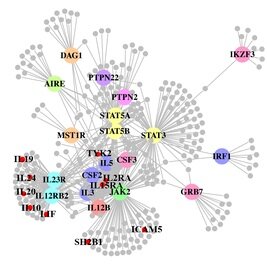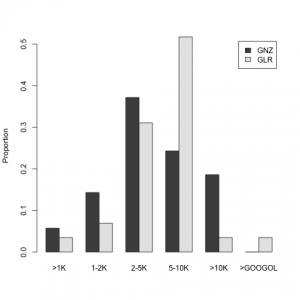 A paper out in PLoS Genetics this week takes a step towards using genome-wide association data to reconstruct functional pathways. Using protein-protein interaction data and tissue-specific expression data, the authors reconstruct biochemical pathways that underlie various diseases, by looking for variants that interact with genes in GWAS regions. These networks can then tell us about what systems are disrupted by GWAS variants as a whole, as well as identifying potential drug targets. The figure to the right shows the network constructed for Crohn’s disease; large colored circles are genes in GWAS loci, small grey circles are other genes in the network they constructed. As an interesting side note, the GWAS variants were taken from a 2008 study; since then, we have published a new meta-analysis, which implicated a lot of new regions. 10 genes in these regions, marked as small red circles on the figure, were also in the disease network. [LJ]
A paper out in PLoS Genetics this week takes a step towards using genome-wide association data to reconstruct functional pathways. Using protein-protein interaction data and tissue-specific expression data, the authors reconstruct biochemical pathways that underlie various diseases, by looking for variants that interact with genes in GWAS regions. These networks can then tell us about what systems are disrupted by GWAS variants as a whole, as well as identifying potential drug targets. The figure to the right shows the network constructed for Crohn’s disease; large colored circles are genes in GWAS loci, small grey circles are other genes in the network they constructed. As an interesting side note, the GWAS variants were taken from a 2008 study; since then, we have published a new meta-analysis, which implicated a lot of new regions. 10 genes in these regions, marked as small red circles on the figure, were also in the disease network. [LJ]
23andMe customers will be interested in a neat little FireFox plug-in that allows them to view their own genotypes for any 23andMe SNP mentioned on a web page. You can download the plug-in here (you’ll need to have an up-to-date version of FireFox), and I have a brief review of the tool here. [DM]
Our GNZ colleague Dan Vorhaus has a fantastic post over at Genomics Law Report summarising what he expects to see in the chaotic world of genomics in 2011. Dan covers likely events in DTC genetic testing, gene patents and regulation, and concludes that we will likely end the year still facing the same challenging issues we were dealing with in 2010. [DM]
A paper in the New England Journal of Medicine reports on the largest survey to date of participants in direct-to-consumer genetic testing. A total of 3,639 participants received discounted testing from Navigenics as part of the Scripps Genomic Health Initiative, and over 2,000 completed surveys exploring their responses to the experience. The results will have come as no great surprise to most readers: the vast majority of the participants showed no evidence of test-related distress (undermining some of the wilder claims from critics of DTC genomics), but there was also very little evidence of positive short-term behaviour changes as a results of receiving a personalised risk assessment (undermining some of the wilder claims from DTC genetic testing companies). It will be interesting to see if these outcomes change as more clinically relevant genetic variants (such as markers of drug response, and severe recessive disease mutations) become available, and as participants are followed up over longer time periods. The study received good coverage in Nature News, Bio-IT World and MIT Technology Review. [DM]
Over at Genetic Future, I review a new paper in Science Translational Medicine describing a sequencing-based approach for finding recessive disease mutations in prospective parents. It’s a very nice paper, and a promising approach: no doubt we’ll see a commercial launch of some version of sequence-based carrier testing this year. [DM]
 Finally, a quick update on our “Googol of Genomes” survey. Dan posted this both here, and over the Genomics Law Report blog, and there are some interesting differences between GLR and GNZ readers. The graph to the right shows the distribution of responses in GNZ and GLR readers (the distributions differ significantly, Fisher’s exact test, p = 0.033). It seems that GNZ readers tend to have a broader range of opinions, whereas GLR readers tend to think more as one mind. Why do you think that is? Survey coming soon. [LJ]
Finally, a quick update on our “Googol of Genomes” survey. Dan posted this both here, and over the Genomics Law Report blog, and there are some interesting differences between GLR and GNZ readers. The graph to the right shows the distribution of responses in GNZ and GLR readers (the distributions differ significantly, Fisher’s exact test, p = 0.033). It seems that GNZ readers tend to have a broader range of opinions, whereas GLR readers tend to think more as one mind. Why do you think that is? Survey coming soon. [LJ]








 RSS
RSS Twitter
Twitter
Thanks for this terrific post.